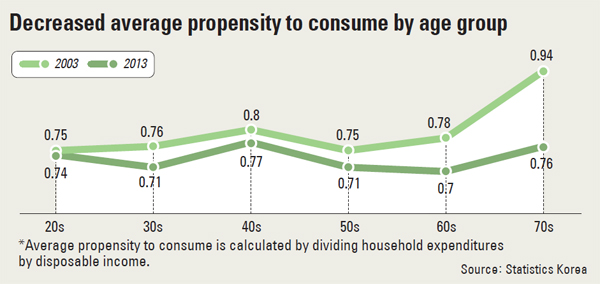Report shows elderly Koreans spending less

The report analyzed the consumption patterns of Koreans by age group for the past 10 years.
Even though the country’s per capita income is approaching $30,000 a year, the report found that people are not able to enjoy their wealth due to institutional problems such as expensive education fees and an increasingly older population.
According to the report, private consumption grew 3.2 percent in the decade since 2003, while GDP rose 4.1 percent.
During the same period, households’ disposable incomes climbed 1.4 percent and their expenditures inched up 0.9 percent.
These indicators show that though they have the money, Koreans are refraining from spending.
The KDI report said the nation’s average propensity to consume is declining.
The consumption propensity refers to a household’s expenditures compared to total disposable income.
Heads of households in their 40s showed a relatively high consumption propensity because they were paying forㄷtheir children’s education, the report said.
“The consumption propensity of Koreans in their 40s, in theory, should turn out to be lower than that, because they earn the most in their lifetime, so they should have more money left after spending,” said Kwon Kyu-ho, an author of the report.
A normal graph of consumption propensity by age group would show a line that drops gradually from the 20s toward the 40s and 50s, and then rises again at the 60s and 70s, making a “U” shape.
However, the report showed that a graph of a normal Korean household makes a “W” because of sharp increases in spending in the 40s age group.
According to the government’s survey of private tuition fees paid per household last year, the total cost stood at 18.6 trillion won. More than 10 trillion won was spent for middle and high school students, whose parents are mostly in their 40s.
While U.S. households, whose heads are in their 40s, spend 2.1 percent of their total disposable incomes, their Korean counterparts spend about 14 percent of their disposable income, the report said.
“Excessive education expenditures are constraining people’s budgets for their retired life,” said Oh Ji-yoon, another author of the report.
In other words, Koreans in their 60s and 70s have turned out to have a relatively high propensity to consume because they have limited savings.
In 2013, those in their 60s spent 8 percentage points less than they did in 2003, while those in their 70s spent 18 percentage points less.
As the population ages, an increasing number of elderly Koreans are concerned about their ability to support themselves, the report said.
“Seniors are not willing to spend, because even though their life span is longer, the period they are allowed to work has been kept the same,” Oh said. “The government should not be focused on short-term measures to boost consumption.”
The researcher said temporary measures won’t solve the consumption problem because it stems from Korea’s societal structure.
BY SONG SU-HYUN [ssh@joongang.co.kr]










with the Korea JoongAng Daily
To write comments, please log in to one of the accounts.
Standards Board Policy (0/250자)